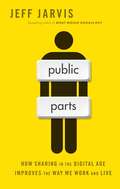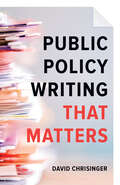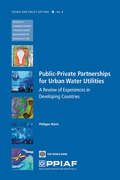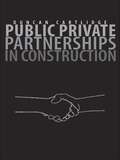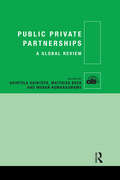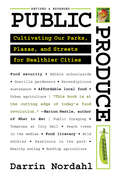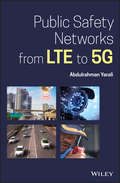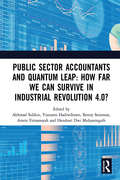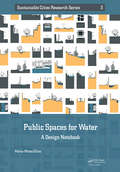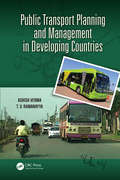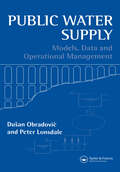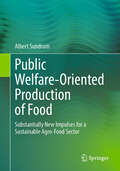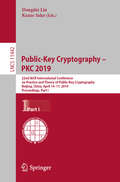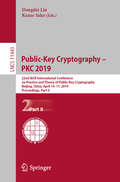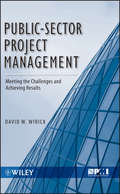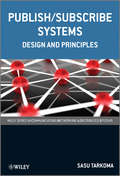- Table View
- List View
Public Parts
by Jeff JarvisA visionary and optimistic thinker examines the tension between privacy and publicness that is transforming how we form communities, create identities, do business, and live our lives.Thanks to the internet, we now live--more and more--in public. More than 750 million people (and half of all Americans) use Facebook, where we share a billion times a day. The collective voice of Twitter echoes instantly 100 million times daily, from Tahrir Square to the Mall of America, on subjects that range from democratic reform to unfolding natural disasters to celebrity gossip. New tools let us share our photos, videos, purchases, knowledge, friendships, locations, and lives.Yet change brings fear, and many people--nostalgic for a more homogeneous mass culture and provoked by well-meaning advocates for privacy--despair that the internet and how we share there is making us dumber, crasser, distracted, and vulnerable to threats of all kinds. But not Jeff Jarvis.In this shibboleth-destroying book, Public Parts argues persuasively and personally that the internet and our new sense of publicness are, in fact, doing the opposite. Jarvis travels back in time to show the amazing parallels of fear and resistance that met the advent of other innovations such as the camera and the printing press. The internet, he argues, will change business, society, and life as profoundly as Gutenberg's invention, shifting power from old institutions to us all.Based on extensive interviews, Public Parts introduces us to the men and women building a new industry based on sharing. Some of them have become household names--Facebook's Mark Zuckerberg, Google's Eric Schmidt, and Twitter's Evan Williams. Others may soon be recognized as the industrialists, philosophers, and designers of our future. Jarvis explores the promising ways in which the internet and publicness allow us to collaborate, think, ways--how we manufacture and market, buy and sell, organize and govern, teach and learn. He also examines the necessity as well as the limits of privacy in an effort to understand and thus protect it. This new and open era has already profoundly disrupted economies, industries, laws, ethics, childhood, and many other facets of our daily lives. But the change has just begun. The shape of the future is not assured. The amazing new tools of publicness can be used to good ends and bad. The choices--and the responsibilities--lie with us. Jarvis makes an urgent case that the future of the internet--what one technologist calls "the eighth continent"--requires as much protection as the physical space we share, the air we breathe, and the rights we afford one another. It is a space of the public, for the public, and by the public. It needs protection and respect from all of us. As Secretary of State Hillary Clinton said in the wake of the uprisings in the Middle East, "If people around the world are going to come together every day online and have a safe and productive experience, we need a shared vision to guide us." Jeff Jarvis has that vision and will be that guide.
Public Policies for Environmental Protection
by Robert N. Stavins Paul Professor PortneyThe first edition of Public Policies for Environmental Protection contributed significantly to the incorporation of economic analysis in the study of environmental policy. Fully revised to account for changes in the institutional, legal, and regulatory framework of environmental policy, the second edition features updated chapters on the EPA and federal regulation, air and water pollution policy, and hazardous and toxic substances. It includes entirely new chapters on market-based environmental policies, global climate change, solid waste, and, for the first time, coverage of the Safe Drinking Water Act. Portney, Stavins, and their contributors provide an invaluable resource for researchers, policymakers, industry professionals, and journalists---anyone who needs up-to-date information on U.S. environmental policy. With their careful explanation of policy alternatives, the authors provide an ideal book for students in courses about environmental economics or environmental politics.
Public Policy Writing That Matters
by David ChrisingerHone your public policy writing—and make a significant impact on the world.Students and professionals across a variety of disciplines need to write public policy in a manner that inspires action and genuine change. You may have amazing ideas about how to improve the world, but if you aren’t able to communicate these ideas well, they simply won’t become reality. In Public Policy Writing That Matters, communications specialist David Chrisinger argues that public policy writing is most persuasive when it tells clear, concrete stories about people doing things. Combining helpful hints and cautionary tales with writing exercises and excerpts from sample policy documents, Chrisinger teaches readers to craft concise, story-driven pieces that exceed the stylistic requirements and limitations of traditional policy writing.Too often, public policy writing is convoluted, opaque, and exclusive. Chrisinger, who teaches introductory policy writing courses around the country, offers a step-by-step guide for anyone interested in planning, organizing, developing, writing, and revising accessible public policy. From the most effective use of data visualization, the best way to write a sentence, and the ideal moment to add a compelling anecdote to advice on using facts to strengthen an argument, this little book, inspired by Strunk & White’s classic style guide, will allow anyone crafting public policy to make a bigger impact. Aimed at helping students and professionals overcome their default impulses to merely "explain," this book reveals proven, classroom-tested tips for writing sophisticated policy that is also easy to understand. This practical, concise handbook will not only aid students throughout graduate school but will also remain a reference to consult throughout their professional careers. A vital tool for any policy writer or analyst, Public Policy Writing That Matters is a book for everyone passionate about using writing to effect real and lasting change.
Public Private Partnership for Desertification Control in Inner Mongolia
by Yong Gao Zhongju Meng Xiaohong DangIn terms of China’s current situation, the prevention and control of land degradation and the development of innovative sustainable land management activities lie within the purview of public works. Further, public-private partnerships (PPPs) hold considerable potential for application in this field. Inner Mongolia is one of the Chinese provinces hardest hit by land degradation. Fortunately, after years of dedicated efforts, meaningful achievements have been made: the increasing participation of the people as a whole, combined with growing investments in land degradation prevention and ecological construction on the part of private enterprises, has to some extent compensated for the lack of government involvement. Further, Inner Mongolia has been a pioneer in the use of PPPs for the prevention and control of land degradation, which has yielded numerous ecological, social and economic benefits. To better promote the development of ecological construction and expand the participation in land degradation control, this book systematically studies the use of PPPs in the Inner Mongolia autonomous region, drawing on field investigations and case analyses to do so. Its main goal is to explore a public-private partnership model that can effectively expand the scale of investment in land degradation prevention and sustainable land management.
Public Private Partnerships for Urban Water Utilities: A Review of Experiences in Developing Countries
by Philippe Marin'Public-Private Partnerships for Urban Water Utilities: A Review of Experiences in Developing Countries' analyzes the market growth of Public-Private Partnerships (PPPs) in the developing world since 1990, and the performance of more than 65 large water PPP projects-representing more than 100 million people-for access, service quality, operational efficiency, and tariff levels. Although a relatively small portion of the water utilities in the developing world are operated under PPPs (about 7 percent in 2007), the urban population served by private water operators has grown every year since 1990. Despite many difficulties encountered by PPP projects and a few contract terminations, a large majority of contracts awarded since 1990 are still in place. The track record for improving service and efficiency reaffirms the value of PPPs to help turn around poorly performing water utilities, even though the level of private financing did not match initial expectations. Over time, a more realistic market has developed, the number of private investors from developing countries has grown, and contract designs have become more pragmatic concerning risk allocations between partners. The water sector has many features that set it apart from other infrastructure sectors. This book suggests the need for careful consideration of those specificities to successfully involve private operators. Although concessions with private financing have worked in a few places, contractual arrangements that combine private operation with public financing appear to be the most sustainable option in many countries. Policy makers, stakeholders, and donors need to remain heavily engaged in the water sector, especially in the poorest countries and during a global financial crisis. This book contributes to a better understanding of the various options to tackle the many challenges of providing water and sanitation services to urban populations in the developing world.
Public Private Partnerships in Construction
by Duncan CartlidgeCollaborative working and partnering between the public and private sectors has been fairly standard practice in some form or other for over 100 years, but it is only in recent years that it has become more prevalent. In the UK, it is little more than ten years since the most widely known Public Private Partnership (PPP), the Private Finance Initiative (PFI), was launched and yet it has already been described by some as 'the new economic paradigm.' Public Private Partnerships in Construction is an authoritative and objective source of information on PPPs, including lessons to be learnt from the past decade, as well as coverage of their spread beyond the UK to governments in areas as diverse as Cambodia and California. With its detailed presentation of current issues, illustrated with case studies, this book provides a valuable practical resource for a range of students and professionals.
Public Private Partnerships in International Construction: Learning from case studies
by Albert P. Chan Esther CheungOver the last ten years public private partnerships have become ever more popular worldwide, expanding the body of experience among construction professionals, government agencies, and industry. In these economically challenging times, PPP has emerged as a crucial framework for providing infrastructure, and also to boost construction industry activity, while shielding the taxpayer from some of the cost. Understanding the lessons learnt is essential to ensuring the success of future projects, and this timely book will prepare the reader to do just that. Starting by defining PPP itself, part one is designed to help the novice to get to grips with the basics of this topic. Part two tackles the practicalities of PPPs, including successful implementation, managing the risks involved, and how to assess the suitability of a project for the PPP route. Part three presents detailed case studies from Asia, Africa, and Australia to illustrate how PPPs should be managed, how problems emerge, and how PPPs can differ across the world. Drawing on extensive internationally conducted research, from both industry and academia, the authors have written the essential PPP guide. Taking into consideration the perspectives of those in the public sector and the private sector, as well as built environment professionals, it is essential reading for anyone preparing to work on public private partnerships in construction.
Public Private Partnerships: A Global Review
by Akintola Akintoye Matthias Beck Mohan KumaraswamyThis timely new book provides an international perspective on Public Private Partnerships. Through 21 case studies, it investigates the existing and fast developing body of principles and practices from a wide range of countries and is the first book to bring together leading international academics and practitioners under a common framework that enables convenient cross-country comparisons. The authors focus on the impact of the financial crisis has had on how governments have reviewed and overhauled their PPP policies as they have examined or tested new ways of partnering more effectively, efficiently and sustainably with the private sector. Readers will be able to gauge the level of maturity of PPP development in the book’s case studies, understand similarities and differences in their practices, and gain useful insights into the regulatory framework and institutional infrastructure in place to support implementation of PPP. Finally, the book offers insights into the future challenges and opportunities that PPP offers stakeholders.
Public Produce: Cultivating Our Parks, Plazas, and Streets for Healthier Cities
by Darrin NordahlPlum and pear trees shade park benches in Kamloops, British Columbia. Tomatoes and cucumbers burst forth from planters at City Hall in Provo, Utah. Strawberries and carrots flourish along the sunny sidewalks of a Los Angeles neighborhood. The idea that public land could be used creatively to grow fresh food for local citizens was beginning to gain traction when Public Produce was first published in 2009, but there were few concrete examples of action. Today, things are different: fruits and vegetables are thriving in parks, plazas, along our streets, and around our civic buildings. This revised edition of Public Produce profiles the many communities and community officials that are rethinking the role of public space in cities, and shows how places as diverse as parking lots and playgrounds can sustain health and happiness through fresh produce. But these efforts produce more than food. Revitalizing urban areas, connecting residents with their neighborhoods, and promoting healthier lifestyles are just a few of the community goods we harvest from growing fruits and vegetables in our public gathering spots. Taking readers from inspiration to implementation, Public Produce is chock full of tantalizing images and hearty lessons for bringing agriculture back into our cities.
Public Safety Networks from LTE to 5G
by Abdulrahman YaraliThis timely book provides an overview of technologies for Public Safety Networks (PSNs). Including real-life examples of network application and services, it introduces readers to the many public safety network technologies and covers the historical developments as well as emerging trends in PSNs such as today’s 4G and tomorrow’s 5G cellular network related solutions. Public Safety Networks from LTE to 5G explores the gradual changes and transformation in the PSNs from the traditional approaches in communications, and examines the new technologies that have permeated this realm, as well as their advantages. It gives readers a look at the challenges public safety networks face by developing solutions for data rates such as introducing broadband data services into safer communication. Topics covered include: TETRA and TETRAPOL; Digital Mobile Radio (DMR), Next-Generation Digital Narrowband (NXDN), Digital Private Mobile Radio (dPMR); and Professional Digital Trunking (PDT). The book also presents information on FirstNet, ESN, and Safenet; Satellite Communications in EMS (Emergency Management) and Public Protection and Disaster Relief (PPDR); Wi-Fi in Ambulances; Technology in Patrol Communications; and more.
Public Sector Accountants and Quantum Leap: Proceedings of the 1st International Conference on Public Sector Accounting (ICOPSA 2019), October 29-30, 2019, Jakarta, Indonesia
by Akhmad Solikin Yuniarto Hadiwibowo Benny Setiawan Amrie Firmansyah Hendrati Dwi MulyaningsihThe Industrial Revolution 4.0 will not only cause job losses, but will also create new workspaces that may not exist today. It also needs to be considered by accountants in government because the processes of budget planning, budget execution, and financial reporting have used a large number of information systems. In the era of the Industrial Revolution 4.0, the changes will be faster, marked by the emergence of such systems as supercomputers, smart robots, cloud computing, big data systems, genetic engineering and the development of neurotechnology that allows humans to optimize brain function further. Industrial Revolution 4.0 will disrupt the accounting profession. This proceedings provides selected papers/research on government accounting, accountability and integrity public sector accounting, financial accounting, accounting information system, auditing and assurance, corporate sustainability, forensic and management accounting, public and corporate finance, taxation and customs, open innovation in public sector accounting. The proceedings provide details beyond what is possible to be included in an oral presentation and constitute a concise but timely medium for the dissemination of recent research results. It will be invaluable to professionals and academics in the field of accounting, finance and the public sector to get an understanding of recent research.
Public Space: The Management Dimension
by Matthew Carmona Claudio De Magalhães Leo HammondIn both the UK and the US there is a sense of dissatisfaction and pessimism about the state of urban environments, particularly with the quality of everyday public spaces. Explanations for this have emphasized the poor quality of design that characterizes many new public spaces; spaces that are dominated by parking, roads infrastructure, introspective buildings, a lack of enclosure and a poor sense of place, and which in different ways for different groups are too often exclusionary. Yet many well designed public spaces have also experienced decline and neglect, as the services and activities upon which the continuing quality of those spaces have been subject to the same constraints and pressures for change as public services in general. These issues touch upon the daily management of public space, that is, the coordination of the many different activities that constantly define and redefine the characteristics and quality of public space. This book draws on three empirical projects to examine the questions of public space management on an international stage. They are set within a context of theoretical debates about public space, its history, contemporary patterns of use and changing nature in western society, and about the new management approaches that are increasingly being adopted.
Public Spaces for Water: A Design Notebook (Sustainable Cities Research Series #3)
by Maria Matos SilvaThis illustrated notebook highlights the need for a change of paradigm in current flood management practices, one that acknowledges the wide-ranging and interdisciplinary benefits brought by public space design. Reassessing and improving established flood management methods, public spaces are faced with a new and enhanced role as mediators of flood adaptation able to integrate infrastructure and communities together in the management of flood water as an ultimate resource for urban resilience. The book specifically introduces a path towards a new perspective on flood adaptation through public space design, stressing the importance of local, bottom up, approaches. Deriving from a solution-directed investigation, which is particularly attentive to design, the book offers a wide range of systematized conceptual solutions of flood adaptation measures applicable in the design of public spaces. Through a commonly used vocabulary and simple technical notions, the book facilitates and accelerates the initial brainstorm phases of a public space project with flood adaptation capacities, enabling a direct application in contemporary practice. Furthermore, it offers a significant sample of real-case examples that may further assist the decision-making throughout design processes. Overall, the book envisions to challenge established professionals, such as engineers, architects or urban planners, to work and design with uncertainty in an era of an unprecedented climate.
Public Transit Planning and Operation: Modeling, Practice and Behavior, Second Edition
by Avishai CederAddresses the Challenges Facing Public Transport Policy Makers and OperatorsPublic Transit Planning and Operation: Modeling, Practice and Behavior, Second Edition offers new solutions for delivering both better services and greater efficiency, solutions which have been developed and tested by the author in over thirty years of research work with ma
Public Transport Optimization
by Konstantinos GkiotsalitisThis textbook provides a comprehensive step-by-step guide for new public transport modelers. It includes an introduction to mathematical modeling, continuous and discrete optimization, numerical optimization, computational complexity analysis, metaheuristics, and multi-objective optimization. These tools help engineers and modelers to use better existing public transport models and also develop new models that can address future challenges. By reading this book, the reader will gain the ability to translate a future problem description into a mathematical model and solve it using an appropriate solution method.The textbook provides the knowledge needed to develop highly accurate mathematical models that can serve as decision support tools at the strategic, tactical, and operational planning levels of public transport services. Its detailed description of exact optimization methods, metaheuristics, bi-level, and multi-objective optimization approaches together with the detailed description of implementing these approaches in classic public transport problems with the use of open source tools is unique and will be highly useful to students and transport professionals.
Public Transport Planning and Management in Developing Countries
by Ashish Verma T.V. RamanayyaDeveloping Countries Have Different Transportation Issues and Requirements Than Developed CountriesAn efficient transportation system is critical for a country's development. Yet cities in developing countries are typically characterized by high-density urban areas and poor public transport, as well as lack of proper roads, parking facilities, road
Public Transport Planning with Smart Card Data
by Fumitaka Kurauchi Jan-Dirk SchmöckerCollecting fares through "smart cards" is becoming standard in most advanced public transport networks of major cities around the world. Travellers value their convenience and operators the reduced money handling fees. Electronic tickets also make it easier to integrate fare systems, to create complex time and space differentiated fare systems, and to provide incentives to specific target groups. A less-utilised benefit is the data collected through smart cards. Records, even if anonymous, provide for a much better understanding of passengers’ travel behaviour as current literature shows. This information can also be used for better service planning. <P><P>Public Transport Planning with Smart Card Data handles three major topics: how passenger behaviour can be estimated using smart card data, how smart card data can be combined with other trip databases, and how the public transport service level can be better evaluated if smart card data is available. The book discusses theory as well as applications from cities around the world and will be of interest to researchers and practitioners alike who are interested in the state-of-the-art as well as future perspectives that smart card data will bring.
Public Water Supply: Models, Data and Operational Management
by Peter Lonsdale Dusan ObradovicProfessionals in the water supply industry are faced with a mass of technical information about how best to use new technologies to improve the efficiency of their supply operations.This book will help explain practical problems and potential solutions clearly and comprehensively to readers who may not be familiar with the latest developments in IT
Public Welfare-Oriented Production of Food: Substantially New Impulses for a Sustainable Agro-Food Sector
by Albert SundrumFood is a means of life. The way it is produced affects us all. Largely unnoticed by the public, a system of the agricultural and food industry has developed in recent decades that supplies us with an abundance of food at excessively low prices. However, the undesirable side effects and external costs of this system have long been ignored. Enormous environmental and climate impacts, loss of biodiversity, animal welfare problems and the continuing death of farms only inadequately describe the true extent of the harmful effects. In the interests of the public welfare, these can no longer be tolerated. However, the complexity of the issues and the diversity of vested interests stand in the way of simple solutions. This professional book provides a comprehensive systemic analysis from very different perspectives and explains how this development has come about. It shows what fundamental changes are needed in all areas in order to find a way out of the destructive pursuit ofcost minimisation through evidence-based quality production. Professionals in the agricultural and food industry and the scientific disciplines involved, including veterinary medicine, as well as decision-makers in political institutions, professional associations and NGOs can use this knowledge to redesign the food sector for the future.
Public-Key Cryptography – PKC 2019: 22nd IACR International Conference on Practice and Theory of Public-Key Cryptography, Beijing, China, April 14-17, 2019, Proceedings, Part I (Lecture Notes in Computer Science #11442)
by Dongdai Lin Kazue SakoThe two-volume set LNCS 11442 and 11443 constitutes the refereed proceedings of the 22nd IACR International Conference on the Practice and Theory of Public-Key Cryptography, PKC 2019, held in Beijing, China, in April 2019. The 42 revised papers presented were carefully reviewed and selected from 173 submissions. They are organized in topical sections such as: Cryptographic Protocols; Digital Signatures; Zero-Knowledge; Identity-Based Encryption; Fundamental Primitives; Public Key Encryptions; Functional Encryption; Obfuscation Based Cryptography; Re- Encryption Schemes; Post Quantum Cryptography.
Public-Key Cryptography – PKC 2019: 22nd IACR International Conference on Practice and Theory of Public-Key Cryptography, Beijing, China, April 14-17, 2019, Proceedings, Part I (Lecture Notes in Computer Science #11442)
by Dongdai Lin Kazue SakoThe two-volume set LNCS 11442 and 11443 constitutes the refereed proceedings of the 22nd IACR International Conference on the Practice and Theory of Public-Key Cryptography, PKC 2019, held in Beijing, China, in April 2019. The 42 revised papers presented were carefully reviewed and selected from 173 submissions. They are organized in topical sections such as: Cryptographic Protocols; Digital Signatures; Zero-Knowledge; Identity-Based Encryption; Fundamental Primitives; Public Key Encryptions; Functional Encryption; Obfuscation Based Cryptography; Re- Encryption Schemes; Post Quantum Cryptography.
Public-Key Cryptography – PKC 2019: 22nd IACR International Conference on Practice and Theory of Public-Key Cryptography, Beijing, China, April 14-17, 2019, Proceedings, Part II (Lecture Notes in Computer Science #11443)
by Dongdai Lin Kazue SakoThe two-volume set LNCS 11442 and 11443 constitutes the refereed proceedings of the 22nd IACR International Conference on the Practice and Theory of Public-Key Cryptography, PKC 2019, held in Beijing, China, in April 2019. The 42 revised papers presented were carefully reviewed and selected from 173 submissions. They are organized in topical sections such as: Cryptographic Protocols; Digital Signatures; Zero-Knowledge; Identity-Based Encryption; Fundamental Primitives; Public Key Encryptions; Functional Encryption; Obfuscation Based Cryptography; Re- Encryption Schemes; Post Quantum Cryptography.
Public-Sector Project Management
by David WirickPublic-Sector Project ManagementMeeting the Challenges and Achieving ResultsDavid W. WirickBusiness & Economics/Project ManagementYour guide to project management success in the public sector There may be no simple formula for success in public-sector projects, but Public-Sector Project Management delivers the next best thing: a complete set of skill-building strategies that puts success well within your reach. Building on industry standards and best practices as well as almost thirty years of public-sector experience, this definitive sourcebook clearly explains how to manage projects in the public sector and navigate their many challenges. Here is where you'll find all the tools to accomplish your goals for any public-sector project, whether you are overseeing military and security operations, the construction of public infrastructure, improving agency processes, deploying new systems or public programs, or any other public initiative. The book describes both the obstacles and basic processes of public-sector project management and examines the differences between public-sector and private-sector projects, including the management of the wide array of public-sector stakeholders. Public-Sector Project Management is your comprehensive professional template for making a positive contribution to your agency or organization. Inside, you'll find: Expert guidance consistent with project management best practices In-depth coverage of public-sector constraints, including purchasing systems, legal mandates, political and media oversight, and complex rules and processes Specific strategies to enhance the management capability of public-sector managers and private-sector project managers working under government contracts Emphasis on the role of planning in managing customer, manager, and project team expectations, and coping with the overlapping systems of constraints that impede public-sector projects Techniques for managing contractors and vendors Tools for managing the complexity inherent in most public-sector projects Insightful case studies of notable and historic public-sector projects; chapter-ending discussion questions and exercises; numerous tables and figures; and key terms in the glossary
Publicly Funded Agricultural Research and the Changing Structure of U.S. Agriculture
by Committee to Review the Role of Publicly Funded Agricultural Research on the Structure of U.S. AgricultureA report on Publicly Funded Agricultural Research and the Changing Structure of U.S. Agriculture
Publish / Subscribe Systems
by Sasu TarkomaThis book offers an unified treatment of the problems solved by publish/subscribe, how to design and implement the solutionsIn this book, the author provides an insight into the publish/subscribe technology including the design, implementation, and evaluation of new systems based on the technology. The book also addresses the basic design patterns and solutions, and discusses their application in practical application scenarios. Furthermore, the author examines current standards and industry best practices as well as recent research proposals in the area. Finally, necessary content matching, filtering, and aggregation algorithms and data structures are extensively covered as well as the mechanisms needed for realizing distributed publish/subscribe across the Internet.Key Features:Addresses the basic design patterns and solutionsCovers applications and example cases including; combining Publish/Subscribe with cloud, Twitter, Facebook, mobile push (app store), Service Oriented Architecture (SOA), Internet of Things and multiplayer gamesExamines current standards and industry best practices as well as recent research proposals in the areaCovers content matching, filtering, and aggregation algorithms and data structures as well as the mechanisms needed for realizing distributed publish/subscribe across the InternetPublish/Subscribe Systems will be an invaluable guide for graduate/postgraduate students and specialists in the IT industry, distributed systems and enterprise computing, software engineers and programmers working in social computing and mobile computing, researchers. Undergraduate students will also find this book of interest.
